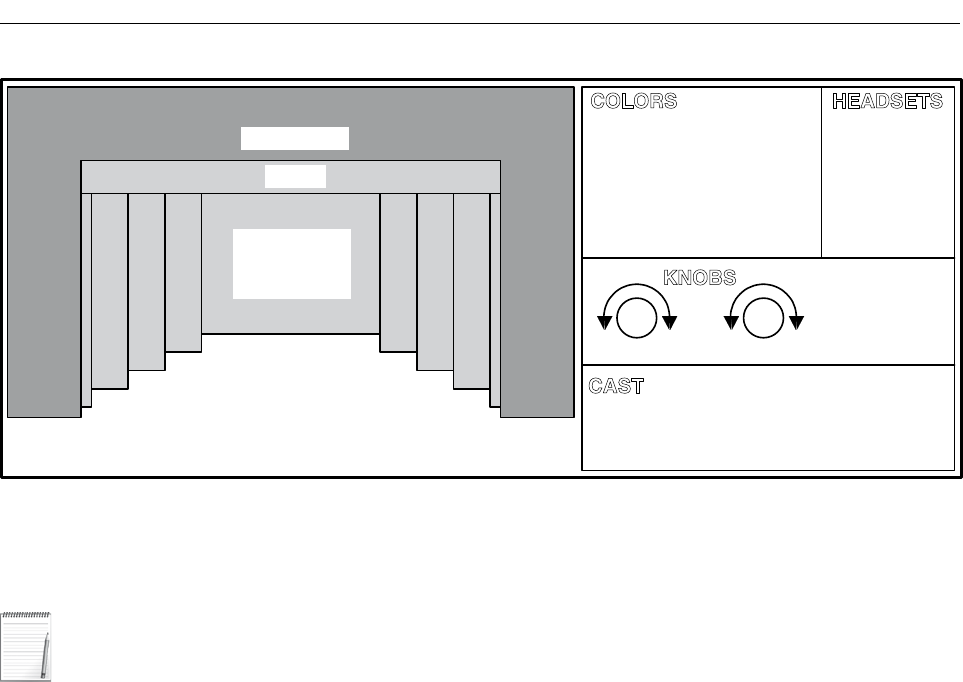
422
●
A PRACTICAL GUIDE TO STAGE LIGHTING
in 4SL
in 1SL
in 3SL
in 2SL
in 4SR
in 1SR
in 3SR
Scenic Stack
BlackScrim
Backdrop
in 2SR
UPSTAGE
DOWNSTAGE
DOWNSTAGE
RIGHT
DOWNSTAGE
LEFT
CENTER
Border
C
OLORS
1. L205-Yellow (Closest)
2. R33-Pink
3. R40-Reddy
4. R64-Blue
5. L128-Green
6. R132-Frost (Furthest)
smallbig darkbrite
KNOBS
HEADSETS
A-Judy SM
Sally ASM
B-Steve LD
Ruth ALD
Mike PE
C
AST
Pookie - Blue/Lav
Hokey - Pink
Low-Raine - Green
Proscenium
Tee-oo - Purple
Wendela - Veils
Father - Brown
Figure 13.5 Followspot Cheat Sheet
The followspot director and operators are now
ready to begin the technical rehearsal.
Shelley’s
Note s
Shelley’s Notes:
Followspots as Guide Lights
The lamps in most followspots are relatively delicate;
many folks think they take more wear and tear being
ignited (striking up) than they do if they’re just left
on. For that reason, if the break time between periods
of spot usage is relatively short, they’re often just left
on. Whether this practice is good or bad is a discus-
sion best left to the lamp experts. For me, though, if
the followspot is going to remain on, it can be put to
good use as an illumination source pointed anywhere
on the stage.
During breaks or in rehearsal when the stage is
being re-set, console programming may still be taking
place, but the brightness of a spot’s beam won’t get in
the way. Rather than douse the followspots so their
beams can’t be seen, I’ll direct the spots toward critical
areas of the stage that are otherwise in complete dark-
ness, and then ask the spot ops to lock their beams off.
Critical areas might include stairs leading to the house,
the edge of the stage, the aisles in the house, ladders, or
piles of scenery that have things sticking out of it. Areas
of the stage that have traffic typically receive no illumi-
nation or are potentially precarious when it’s dark.
During breaks in the tech, or breaks over cof-
fee, “parking” the spot beams at these predetermined
locations means that folks can still move about the
stage in semi-darkness and console cueing can still
take place, without the need to fumble around and
turn on the worklights. If need be, the followspots
can be doused out by the operator.
During rehearsals I’ll assign each followspot to
a default location; my first choice is often the stair
access between the audience and the stage. As soon as
a scene has been halted, I give the instruction “spots,
please move to your park points,” and the spots leave
their pickups on stage (presuming they’re not needed
for light cue work), move to their respective guide
points, and lock off. The followspots can then relax
for a moment, and the critical areas of movement
are lit. When the rehearsal’s ready to start back up,
I’ll give the instruction “spots unlock and back to
your positions at the top of the scene.” If someone is
still moving through a parked spot at a guide point,
that will be seen and accounted for. In this way, no
matter when performers want to move to or from the
stage, or move about the stage, they’re not travers-
ing in darkness. Using the followspots as guide lights
speeds the rehearsal process, and increases the safety
of working in the dark.
THE TECHNICAL REHEARSAL
Some say that the primary objective of technical
rehearsals is to safely add performers to the techni-
cal elements of the production. While most agree that
statement is true, from a broader perspective, the
technical rehearsal is a whole slew of things: it’s also
the first peek toward the production’s visual concept,
and the first step toward realizing the overall flow of
the show. The technical rehearsal is the opportunity
for the director and the creative team to clarify the
stage pictures, and to decide if all the choices that
have been made, design or otherwise, will fully (or
have a snowball’s chance) to succeed. To achieve this
goal, the initial objective of the technical rehearsal is
Get A Practical Guide to Stage Lighting, 2nd Edition now with the O’Reilly learning platform.
O’Reilly members experience books, live events, courses curated by job role, and more from O’Reilly and nearly 200 top publishers.

